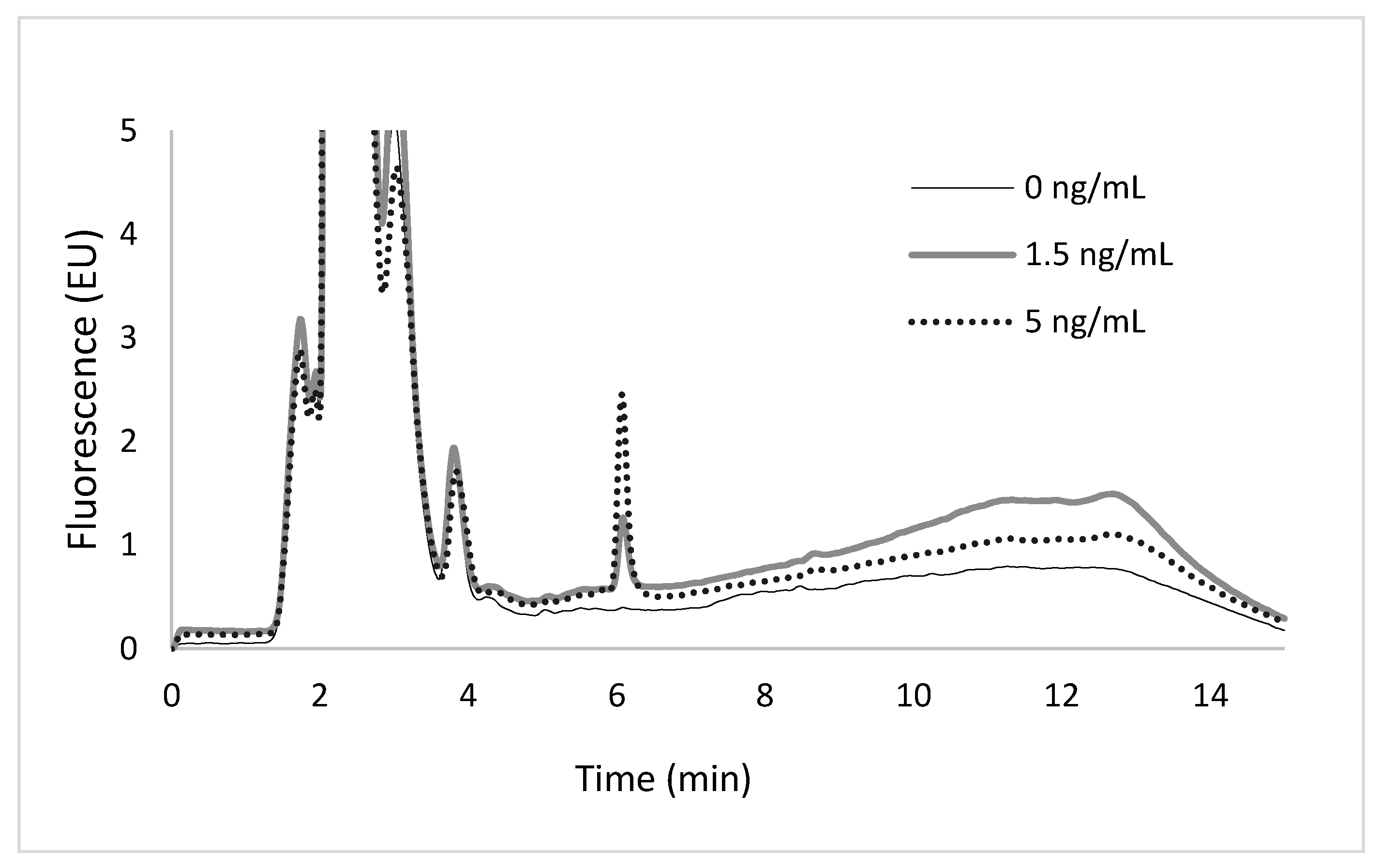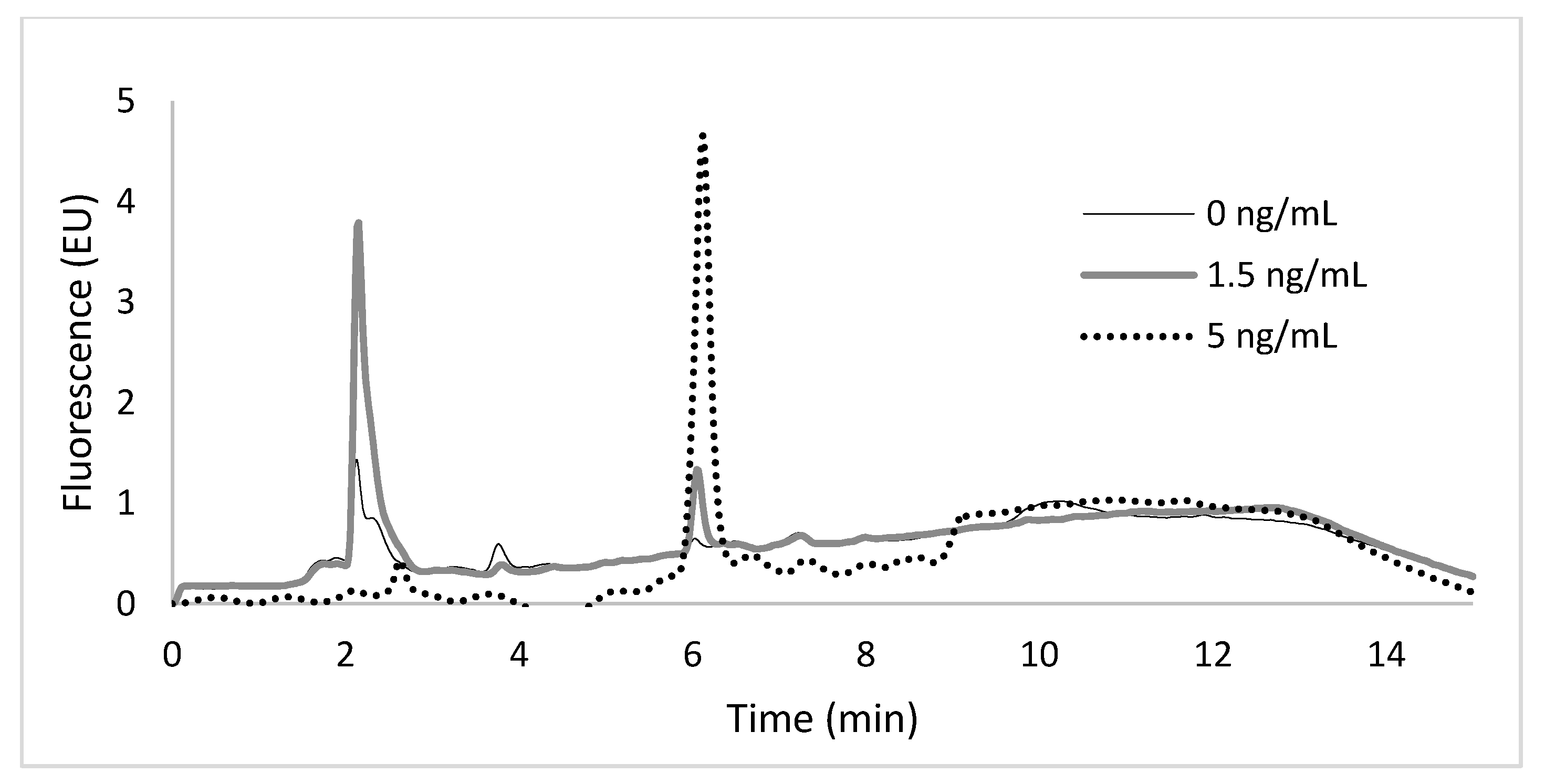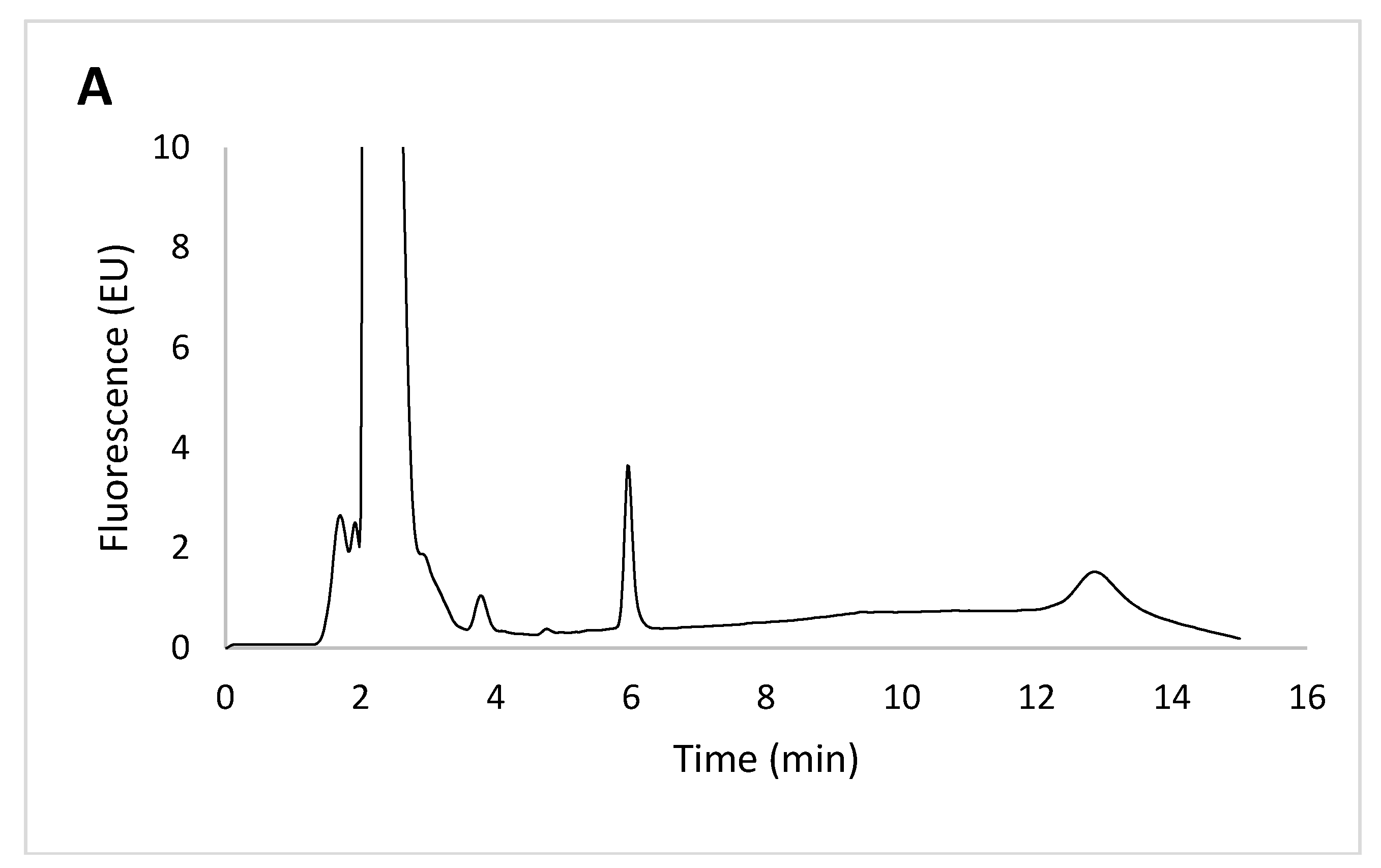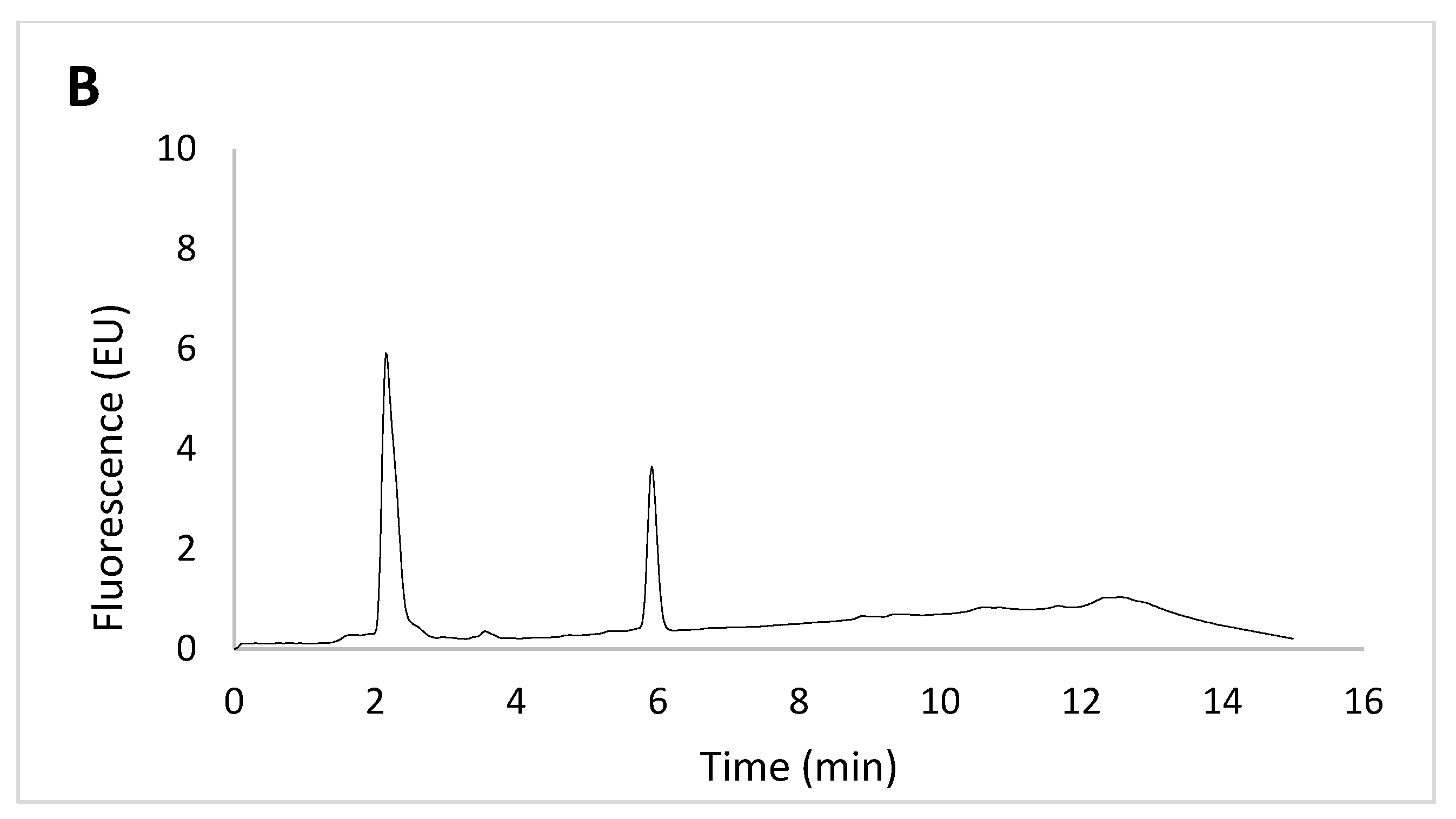HPLC Method Development for Quantification of Doxorubicin in Cell Culture and Placental Perfusion Media
Abstract
:1. Introduction
2. Materials and Methods
2.1. Chemicals and Reagents
2.2. Chromatographic Instruments and Conditions
2.3. Sample Preparation
2.4. Transplacental Transfer of DXR across BeWo Cells and the Dually Perfused Human Placental Lobule
2.5. Assay Validation
2.5.1. Linearity, Precision, and Accuracy
2.5.2. Limits of Detection and Quantification
2.5.3. Stability of Samples
3. Results and Discussion
3.1. HPLC Method Development
3.2. Linearity, Precision, and Accuracy
3.3. Limits of Detection and Quantification
3.4. Sample Stability
3.5. Transplacental Transfer of DXR across BeWo Cells and the Dually Perfused Human Placental Lobule
4. Conclusions
Acknowledgments
Author Contributions
Conflicts of Interest
References
- Daw, J.R.; Hanley, G.E.; Greyson, D.L.; Morgan, S.G. Prescription drug use during pregnancy in developed countries: A systematic review. Pharmacoepidemiol. Drug Saf. 2011, 20, 895–902. [Google Scholar] [CrossRef] [PubMed]
- Loebstein, R.; Lalkin, A.; Koren, G. Pharmacokinetic changes during pregnancy and their clinical relevance. Clin. Pharmacokinet. 1997, 33, 328–343. [Google Scholar] [CrossRef] [PubMed]
- Soininen, S.K.; Repo, J.K.; Karttunen, V.; Auriola, S.; Vähäkangas, K.H.; Ruponen, M. Human placental cell and tissue uptake of doxorubicin and its liposomal formulations. Toxicol. Lett. 2015, 239, 108–114. [Google Scholar] [CrossRef] [PubMed]
- Speth, P.A.J.; van Hoesel, Q.G.C.M.; Haanen, C. Clinical Pharmacokinetics of Doxorubicin. Clin. Pharmacokinet. 1988, 15, 15–31. [Google Scholar] [CrossRef] [PubMed]
- Gabizon, A.; Shmeeda, H.; Barenholz, Y. Pharmacokinetics of Pegylated Liposomal Doxorubicin. Clin. Pharmacokinet. 2003, 42, 419–436. [Google Scholar] [CrossRef] [PubMed]
- Chiannilkulchai, N.; Ammoury, N.; Caillou, B.; Devissaguet, J.P.; Couvreur, P. Hepatic tissue distribution of doxorubicin-loaded nanoparticles after i.v. administration in reticulosarcoma M 5076 metastasis-bearing mice. Cancer Chemother. Pharmacol. 1990, 26, 122–126. [Google Scholar] [CrossRef] [PubMed]
- Cartwright, L.; Poulsen, M.; Nielsen, H.; Pojana, G.; Knudsen, L.E.; Saunders, M.; Rytting, E. In vitro placental model optimization for nanoparticle transport studies. Int. J. Nanomed. 2012, 7, 497–510. [Google Scholar]
- Saunders, M. Transplacental transport of nanomaterials. Wiley Interdiscip. Rev. Nanomed. Nanobiotechnol. 2009, 1, 671–684. [Google Scholar] [CrossRef] [PubMed]
- Alhareth, K.; Vauthier, C.; Gueutin, C.; Ponchel, G.; Moussa, F. HPLC quantification of doxorubicin in plasma and tissues of rats treated with doxorubicin loaded poly(alkylcyanoacrylate) nanoparticles. J. Chromatogr. B Anal. Technol. Biomed. Life Sci. 2012, 887–888, 128–132. [Google Scholar] [CrossRef] [PubMed]
- Daeihamed, M.; Haeri, A.; Dadashzadeh, S. A Simple and Sensitive HPLC Method for Fluorescence Quantitation of Doxorubicin in Micro-volume Plasma: Applications to Pharmacokinetic Studies in Rats. Iran. J. Pharm. Res. IJPR 2015, 14, 33–42. [Google Scholar] [PubMed]
- Beijnen, J.H.; Meenhorst, P.L.; Van Gijn, R.; Fromme, M.; Rosing, H.; Underberg, W.J.M. HPLC determination of doxorubicin, doxorubicinol and four aglycone metabolites in plasma of AIDS patients. J. Pharm. Biomed. Anal. 1991, 9, 995–1002. [Google Scholar] [CrossRef]
- Lucas, A.T.; O’Neal, S.K.; Santos, C.M.; White, T.F.; Zamboni, W.C. A sensitive high performance liquid chromatography assay for the quantification of doxorubicin associated with DNA in tumor and tissues. J. Pharm. Biomed. Anal. 2016, 119, 122–129. [Google Scholar] [CrossRef] [PubMed]
- Camaggi, C.M.; Comparsi, R.; Strocchi, E.; Testoni, F.; Pannuti, F. HPLC analysis of doxorubicin, epirubicin and fluorescent metabolites in biological fluids. Cancer Chemother. Pharmacol. 1988, 21, 216–220. [Google Scholar] [CrossRef] [PubMed]
- Urva, S.R.; Shin, B.S.; Yang, V.C.; Balthasar, J.P. Sensitive high performance liquid chromatographic assay for assessment of doxorubicin pharmacokinetics in mouse plasma and tissues. J. Chromatogr. B 2009, 877, 837–841. [Google Scholar] [CrossRef] [PubMed]
- Arnold, R.; Slack, J.; Straubinger, R. Quantification of doxorubicin and metabolites in rat plasma and small volume tissue samples by liquid chromatography/electrospray tandem mass spectroscopy. J. Chromatogr. B 2004, 808, 141–152. [Google Scholar] [CrossRef] [PubMed]
- Niu, H.; Xu, M.; Li, S.; Chen, J.; Luo, J.; Zhao, X.; Gao, C.; Li, X. High-Performance Liquid Chromatography (HPLC) Quantification of Liposome-Delivered Doxorubicin in Arthritic Joints of Collagen-Induced Arthritis Rats. Med. Sci. Monit. Basic Res. 2017, 23, 150–158. [Google Scholar] [CrossRef] [PubMed]
- Berveiller, P.; Vinot, C.; Mir, O.; Broutin, S.; Deroussent, A.; Seck, A.; Camps, S.; Paci, A.; Gil, S.; Tréluyer, J.M. Comparative transplacental transfer of taxanes using the human perfused cotyledon placental model. Am. J. Obstet. Gynecol. 2012, 207, 514.e1–514.e7. [Google Scholar] [CrossRef] [PubMed]
- Nekhayeva, I.A.; Nanovskaya, T.N.; Pentel, P.R.; Keyler, D.E.; Hankins, G.D.; Ahmed, M.S. Effects of nicotine-specific antibodies, Nic311 and Nic-IgG, on the transfer of nicotine across the human placenta. Biochem. Pharmacol. 2005, 70, 1664–1672. [Google Scholar] [CrossRef] [PubMed]
- Albekairi, N.A.; Al-Enazy, S.; Ali, S.; Rytting, E. Transport of digoxin-loaded polymeric nanoparticles across BeWo cells, an in vitro model of human placental trophoblast. Ther. Deliv. 2015, 6, 1325–1334. [Google Scholar] [CrossRef] [PubMed]
- Earhart, A.; Patrikeeva, S.; Wang, X.; Abdelrahman, D.R.; Hankins, G.; Ahmed, M.; Nanovskaya, T. Transplacental transfer and metabolism of bupropion. J. Matern. Neonatal Med. 2009, 23, 1–10. [Google Scholar] [CrossRef] [PubMed]
- ICH Guidlines. Guidances (Drugs)—Q2 (R1) Validation of Analytical Procedures: Text and Methodology. 2005. Available online: https://www.fda.gov/Drugs/GuidanceComplianceRegulatoryInformation/Guidances/ucm265700.htm (accessed on 27 February 2017).
- Clark, C.R.; Dowling, P.M.; Boison, J.O. Development and validation of a method for determination of tilmicosin residues in equine plasma and tissues using HPLC. J. Liq. Chromatogr. Relat. Technol. 2009, 32, 2839–2856. [Google Scholar] [CrossRef]
- Van Calsteren, K.; Verbesselt, R.; Beijnen, J.; Devlieger, R.; De Catte, L.; Chai, D.C.; Van Bree, R.; Heyns, L.; de Hoon, J.; Amant, F. Transplacental transfer of anthracyclines, vinblastine, and 4-hydroxy-cyclophosphamide in a baboon model. Gynecol. Oncol. 2010, 119, 594–600. [Google Scholar] [CrossRef] [PubMed]




| Regression Parameters | Day 1 | Day 2 | Day 3 | Average | Standard Deviation | RSD (%) |
|---|---|---|---|---|---|---|
| DMEM/F-12 | ||||||
| Intercept | 4191.9 | 2513.3 | 3749.7 | 3485.0 | 870.1 | 24.9 |
| Slope | 3.761 × 107 | 3.940 × 107 | 3.753 × 107 | 3.818 × 107 | 1.06 × 106 | 2.7 |
| R2 | 0.9996 | 0.9988 | 0.9954 | 0.9979 | 0.002 | 0.2 |
| Fetal M199 | ||||||
| Intercept | 10253.5 | 9697.6 | 10453.9 | 10135.0 | 391.9 | 3.9% |
| Slope | 4.592 × 107 | 4.341 × 107 | 4.228 × 107 | 4.387 × 107 | 1.86 × 106 | 4.2% |
| R2 | 0.9974 | 0.9966 | 0.9993 | 0.9978 | 0.001 | 0.1% |
| Concentration (µg/mL) | Intra-Day Precision (%) | Inter-Day Precision (%) | Accuracy (%) | ||
|---|---|---|---|---|---|
| Day 1 | Day 2 | Day 3 | |||
| DMEM/F-12 | |||||
| 0.05 | 5.7 | 1.2 | 1.9 | 7 | 96.4 |
| 5 | 2.6 | 5.3 | 9.1 | 3.3 | 101.6 |
| 10 | 2.7 | 10.3 | 6.4 | 1.2 | 100.1 |
| Fetal M199 | |||||
| 0.05 | 4.1 | 3.5 | 3.6 | 11.3 | 103.1 |
| 5 | 2.8 | 2.8 | 3.4 | 0.9 | 100.2 |
| 10 | 0.5 | 1.6 | 3.2 | 6.3 | 102.8 |
| Measured Concentration (µg/mL) | Matrix Factor (%) | |
|---|---|---|
| DMEM/F12 | Fetal M199 | |
| 0.01 | 113.1 ± 6.4 | 101.1 ± 10.8 |
| 10.0 | 109.7 ± 7.0 | 96.6 ± 9.4 |
| Nominal Concentration (µg/mL) | Measured Concentration (µg/mL) | ||
|---|---|---|---|
| Day 1 | Day 8 | % Change | |
| In DMEM/F12 cell culture media | |||
| 0.05 | 0.050 | 0.049 | 1.3% |
| 5 | 5.02 | 4.44 | 11.5% |
| 10 | 10.19 | 9.57 | 6.1% |
| In fetal placental perfusion media | |||
| 0.05 | 0.052 | 0.048 | 8.5% |
| 5 | 4.80 | 4.45 | 7.2% |
| 10 | 10.50 | 10.53 | 0.3% |
© 2018 by the authors. Licensee MDPI, Basel, Switzerland. This article is an open access article distributed under the terms and conditions of the Creative Commons Attribution (CC BY) license (http://creativecommons.org/licenses/by/4.0/).
Share and Cite
Shah, M.; Bourner, L.; Ali, S.; Al-Enazy, S.; Youssef, M.M.; Fisler, M.; Rytting, E. HPLC Method Development for Quantification of Doxorubicin in Cell Culture and Placental Perfusion Media. Separations 2018, 5, 9. https://doi.org/10.3390/separations5010009
Shah M, Bourner L, Ali S, Al-Enazy S, Youssef MM, Fisler M, Rytting E. HPLC Method Development for Quantification of Doxorubicin in Cell Culture and Placental Perfusion Media. Separations. 2018; 5(1):9. https://doi.org/10.3390/separations5010009
Chicago/Turabian StyleShah, Mansi, Luke Bourner, Shariq Ali, Sanaalarab Al-Enazy, Menatallah M. Youssef, Morgan Fisler, and Erik Rytting. 2018. "HPLC Method Development for Quantification of Doxorubicin in Cell Culture and Placental Perfusion Media" Separations 5, no. 1: 9. https://doi.org/10.3390/separations5010009
APA StyleShah, M., Bourner, L., Ali, S., Al-Enazy, S., Youssef, M. M., Fisler, M., & Rytting, E. (2018). HPLC Method Development for Quantification of Doxorubicin in Cell Culture and Placental Perfusion Media. Separations, 5(1), 9. https://doi.org/10.3390/separations5010009





